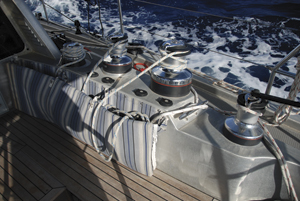To the editor: Running rigging offshore (Issue 202, May/June 2012) contains much wise advice. However, I disagree with Paul Exner’s suggestion that the mast is the preferred reefing station. The harder it blows the less I like to leave the safety of my cockpit. On our old boat I would pray for the wind to go down so I would not have to face the maelstrom on deck to reef. My prayer was seldom heard.
I had a chance to look at the options when our new boat was being designed. I was put off by the expense and the difficulties of furling off the wind with the in boom furling systems. Our Kiwi boatbuilder, Kelly Archer, convinced me that single line slab reefing would work on our 62-footer, Onora. This system is occasionally found on small boats but it is seldom seen on larger vessels.
It is simple enough. The reefing line is tied to the mainsail luff reef point and run down into the boom and aft where it runs up to the leech reef point (around a block that is sewn into the sail) and back inside the boom where it returns to the front. Here it drops down to a deck block and is guided by a deck organizer back to a cockpit jammer.
 |
|
Organizer bags used to corral loose lines and keep the cockpit neat. |
The main halyard also runs to this jammer. The jammers allow our cockpit winches do double duty. If needed, the sheets can be strung across the cockpit to use windward winches.
In his article, Exner raises the issue of lines cluttering up the cockpit. We solve this by stowing our sheets in bags that hang over the coaming. They also serve as padded back rests.
With the autopilot steering, this system allows one person to tie in a reef in a few minutes without leaving the safety of the cockpit.
—After a diversion to Greenland and the Baltic, Jim and Jean Foley are heading south to complete their second circumnavigation by way of the southern capes. Their boat, Onora, was designed by Chuck Paine and built by Kelly Archer in New Zealand.
